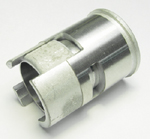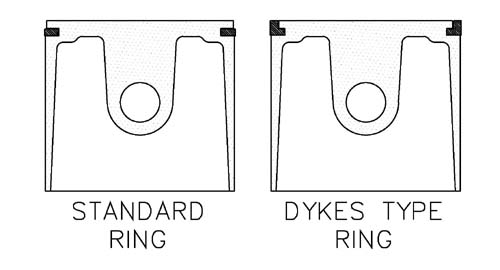|
ABC,
RINGED, and LAPPED refer to piston/cylinder assemblies.
|
|
ABC has become
the most common type of piston/cylinder arrangement for smaller
engines in recent years. Some ABC type engines actually use
nickel plating instead of chrome for the wear surface. Nickel
is less expensive because it is more environmentally friendly,
however chrome has a much slicker surface for less friction.
The
ABC type piston and cylinder are manufactured as a matched
set,
you can not purchase a piston or cylinder separately.
The only exception to this is if the piston has a ring
like with some HP and WEBRA engines.
|
|
|
ABC,
ABN and AAC engines all fall under the same design category
ABC Ringed will not have the "pinch" or tight spot
at the top of the stroke.
|
|
ABC
|
ABN
|
AAC
|
|
A -- refers to Aluminum Piston
|
A
-- refers to Aluminum Piston
|
A
-- refers to Aluminum Piston
|
|
B
-- refers to Brass Cylinder
|
B
-- refers to Brass Cylinder
|
A
-- refers to Aluminum Cylinder
|
|
C
-- refers to Hard Chrome plating
|
N
-- refers to Electroless Nickel plating
|
C
-- refers to Hard Chrome plating
|
|
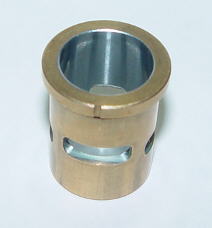 |
You
can tell an ABC engine by looking in the exhaust port.
The cylinder will be brass and the inner wall of the
cylinder will have chrome plating.
The
piston will be aluminum color and usually has oil retention
grooves cut into it.
ABC engines
have a tight fit so the oil film is easily wiped away
with each stroke.
|
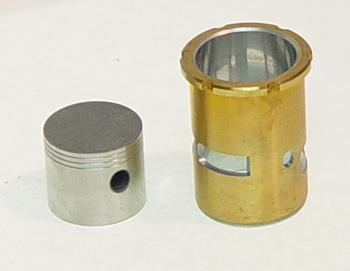 |
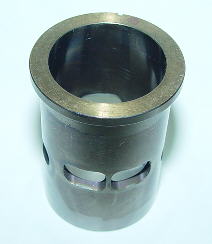 |
An
ABN engine is a little more difficult to distinguish.
The cylinder is completely plated inside and out with
Nickel so it may appear to be Steel. No brass is showing.
The piston will be aluminum color and usually has oil
retention grooves cut into it as shown above. On this
example the top flange has been machined exposing the
brass.
A side
note...
The small notch cut into the flange is actually there
for location purposes during manufacturing. It was not
placed there to align the sleeve the the crankcase.
It has been utilized for this in some engines, but it
is not necessary for it to be "pin located"
in the crankcase.
|
|
|
You
can tell an AAC engine by looking in the exhaust port.
The cylinder will be light aluminum color and the inner
wall of the cylinder will have chrome plating. The piston
will be aluminum color and usually has oil retention grooves
cut into it. |
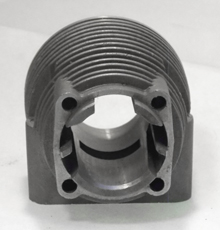 |
The
other AAC type is like in the K&B Sportster. The cylinder
and fins is all one piece and the piston is hard chrome
plated. This type of piston does not have oil retention
grooves but has a hard chrome appearance. |
|
|
|
|
ABC type engines
are intentionally manufactured with a “taper” in
the cylinder so you will feel a "binding” when the
piston is moving through the top of its stroke. You may also
detect what seems like a dead spot or disconnected feeling
of the crankshaft and you may even hear a clicking sound when
the piston is at this point.
These feelings
and sounds are the result of the taper (binding) in the cylinder
affecting the required clearances in the connecting rod ends.
All of these conditions are normal.
As the ABC type
engine obtains operating temperature the cylinder becomes
straight and the clearances between the piston and cylinder
become correct. The straightening is due to the top of the
cylinder running at a higher temperature than the bottom,
thus the top expands more.
It is also normal
for compression to sometimes feel poor when the engine is
stopped and turned over while still hot. This is due to the
piston cooling faster than the cylinder. If the engine temperature
is allowed to stabilize the compression will return to normal.
ABC type engines
must be broken in properly. Click
here to learn how.
|
|
|
|
|
There
are two basic ring types for model engines, DYKE'S and CONVENTIONAL
|
|
A
DYKE'S type ring is a "L" shaped ring that fits
at the very top edge of the piston.
Many people can not even see it as there is no piston material
above it. Dyke's rings do not feel like they are working (no
compression) when the engine is turned over by hand. A dyke's
type ring is pressure activated, (it is like a dyke) when
pressure pushes against the inner side of the ring it is pushed
out tightly to the cylinder wall. When it is running past
the ports no pressure is pushing it so there is less friction.
This is why dyke's rings produce more power than conventional
type rings.
|
|
|
|
A
conventional ring is just that. It has a rectangular profile
and fits into a groove usually about a 1/16" down from
the top of the piston. Conventional rings, when broken in
properly, provide a good seal at any speed. Conventional rings
have constant tension that force them against the cylinder.
When you flip a good conventional ringed engine over it feels
great with snappy compression.
|
|
|
|
|
| A lapped engine
has a steel liner and an iron piston that are lapped together
to a perfect fit. When you flip a lapped engine over you will
feel a perfect seal and good snap of compression. |
|
| These type of piston/cylinder
sets are matched and can not be purchased separately. |
|
| Lapped engines must
be broken in properly. Click
here to learn how. |




